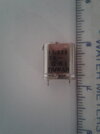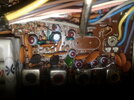I need to source an 11.325 MHz crystal for my Cobra 2000.
It's part# X3 QX-086, 11.325 MHz in the SAMS manual, but that's all it tells me.
I can have one cut locally as a one-off, but they are wanting all sorts of data like ESR,
f stability, calibration tolerance, load capacitance, shunt capacitance, storage/op temperature
range etc etc., and have probably never heard of a Cobra 2000 before.
Barkett Electronics have them, but don't ship outside the USA.
There are 2 ebay sellers, which can be easily found, who are selling lots and will ship to 43 division.
But they appear to be smaller type 49 holders, rather than the original type 51.
Anyone with experience of these? Any significance in the 11.3258 MHz?
The 2nd picture shows where it goes on the board using the outer 2 holes
for the leads.
Are the 2 inner holes there to accept the smaller type holder?
Radio is in storage right now, so can't see the solder side of the board.
Hope these pics post OK.
Thanks & 73's
 View attachment 58865
View attachment 58865
It's part# X3 QX-086, 11.325 MHz in the SAMS manual, but that's all it tells me.
I can have one cut locally as a one-off, but they are wanting all sorts of data like ESR,
f stability, calibration tolerance, load capacitance, shunt capacitance, storage/op temperature
range etc etc., and have probably never heard of a Cobra 2000 before.
Barkett Electronics have them, but don't ship outside the USA.
There are 2 ebay sellers, which can be easily found, who are selling lots and will ship to 43 division.
But they appear to be smaller type 49 holders, rather than the original type 51.
Anyone with experience of these? Any significance in the 11.3258 MHz?
The 2nd picture shows where it goes on the board using the outer 2 holes
for the leads.
Are the 2 inner holes there to accept the smaller type holder?
Radio is in storage right now, so can't see the solder side of the board.
Hope these pics post OK.
Thanks & 73's
 View attachment 58865
View attachment 58865
